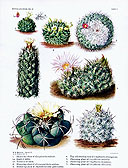
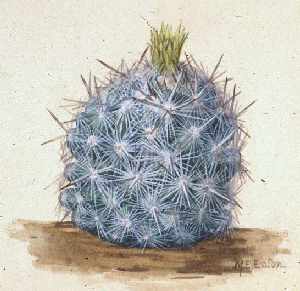
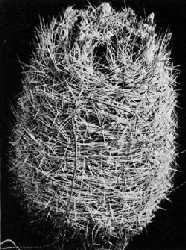
Eaton, M.E.
Coryphantha chlorantha (Engelmann) Nathaniel Lord Britton et Joseph Nelson Rose comb. nov. , The Cactaceae, 4 : 43, pl. 5, f. 7, 1923
Descriptio:
30. Coryphantha chlorantha (Engelmann) N.L.Britton et J.N.Rose comb. nov.
Mammillaria chlorantha Engelmann in Rothrock, Rep. U. S. Geogr. Surv. 6:127. 1878.
Cactus radiosus chloranthus Coulter, Contr. U. S. Nat. Herb. 3: 121. 1894.
Mammillaria radiosa chlorantha * Schumann, Gesamtb. Kakteen 481. 1898.
Plant cylindric, sometimes 20 to 25 cm. high, 8 cm. in diameter; tubercles closely set and entirely
hidden by the densely matted spines; flowers small, 35 mm. broad; outer perianth-segments
ciliate; inner perianth-segments yellow or greenish yellow, linear-lanceolate, acute; stigma-lobes white;
fruit central, green, 2.5 cm. long, juicy, bearing 5 or 6 scales near top; seeds brown, flattened, 1.5
mm. long, reticulated.
Type locality: Southern Utah, east of Saint George.
Distribution: Southern Utah, western Arizona, central Nevada, and eastern southern
California.
Mammillaria utahensis Hildmann, cited by Schumann (Gesamtb. Kakteen 481.
1898) as a synonym of M. radiosa, may have been based on this plant.
Illustrations: Förster, Handb. Cact. ed. 2. 328. f. 33; Gartenflora 32: 87; Deutsche
Gärt. Zeit. 7: 53, as Mammillaria chlorantha; Schelle, Handb. Kakteenk. 236. f. 151, as
M. radiosa chlorantha.
Plate v, figure 7, is from a plant collected by I. Tidestrom at the type locality in 1919,
which flowered in the New York Botanical Garden, May 27, 1919. Figure 42 is from a
photograph of a plant collected by Major E. A. Goldman in Prospect Valley, Arizona.
--------------------------------------------------------------------------------------------------------------
* Schumann credits this trinomial to Engelmann at the place here cited, although we believe that Engelmann
never used it.
 |
 |
 |
| The Cactaceae, 4, pl. 5 | The Cactaceae, 4, pl. 5, f. 7 Eaton, M.E. |
Fig. 42 - Coryphantha chlorantha. |
Coryphantha vivipara (Nuttall) Britton and Rose in Britton et Rose, The Cactaceae, 4 : 43, 1923
Descriptio:
31. Coryphantha vivipara (Nuttall) Britton and Rose in Britton and Brown
Illustr. Fl. ed. 2. 2: 571. 1913.
Cactus viviparus Nuttall, Fraser’s Cat. No. 22. 1813.
Mammillaria vivipara Haworth, Suppl. Pl. Succ. 72. 1819.
Mammillaria radiosa Engelmann, Bost. Journ. Nat. Hist. 6: 196. 1850.
Echinocactus radiosus Poselger, Allg. Gartenz. 21: 107. 1853.
Echinocactus viviparus Poselger, Allg. Gartenz. 21: 107. 1853.
Mammillaria vivipara vera Engelmann, Proc. Amer. Acad. 3: 269. 1856.
Mammillaria vivipara radiosa Engelmann, Proc. Amer. Acad. 3: 269. 1856.
Mammillaria vivipara radiosa Engelmann, Cact. Mex. Bound. 15. 1859, as subspecies.
Cactus radiosus Coulter, Contr. U. S. Nat. Herb. 3: 120. 1894.
Mammillaria hirschtiana Haage, Monatsschr. Kakteenk. 6: 127. 1896.
Coryphantha radiosa Rydberg, Fl. Rocky Mountains 581. 1917.
Plants solitary or in clusters forming mounds 3 to 6 dm. in diameter, globular, with prominent
tubercles; areoles large, woolly; radial spines about 16, rather delicate, radiating, white; centrals to
6, divergent, much stouter, brownish, swollen at base; ovary green, naked; outer perianth-segments
greenish; inner ones somewhat pinkish, long-ciliate; innermost perianth-segments pinkish purple,
narrow, acuminate, entire, spreading; filaments much shorter than the segments, pinkish, but paler
below; style greenish to purple above, longer than the stamens; stigma-lobes linear, purple, about
8, apiculate; fruit green when mature, juicy, nearly globular, 1.5 cm. in diameter, with several
(sometimes 5 or 6) small ciliate scales scattered over its surface; seeds light brown, 1.5 mm. long.
Type locality: “Near the Mandan towns on the Missouri, lat. near 49°.”
Distribution: Manitoba to Alberta, Kansas, south to northern Texas and Colorado.
The group to which Coryphantha vivipara belongs has always been very puzzling.
Dr. Engelmann, our greatest authority on this group, was sometimes of one opinion
and sometimes of another. Schumann rejected the specific name vivipara of Haworth
for this plant since he thought that it was not the same as the vivipara of Engelmann,
but in this he must be wrong, for Mammillaria vivipara Haworth was based upon Cactus
viviparus Pursh, a name previously used by Nuttall, and both Pursh’s and Nuttall’s
descriptions were based on the specimens collected by Nuttall in “Upper Louisiana” in
1812. This is undoubtedly the plant which Engelmann had in mind and which he called
variety vera. We have not seen the type, but Pursh stated that he had seen flowers in
Lambert’s Garden.
Engelmann’s remarks regarding the variability of the species are interesting. In the Proceedings
of the American Academy (3: 269) he says:
“The extreme forms are certainly very unlike one another, but the transitions are so gradual
that I can not draw strict limits between them.”
Coryphantha vivipara and the three following species are closely related.
This plant is a day bloomer, and according to Engelmann the flowers become fully
expanded about one o’clock in the afternoon.
Hooker in Curtis’s Botanical Magazine (pl. 7718) figures and describes a plant purchased
from D. M. Andrews of Boulder, Colorado, in which all the spines are brown, the flower
is rose-red, and the stigma-lobes are linear and white.
Mammillaria montana is described briefly and figured (f. 1399) by Blanc in Hints on
Cacti, p. 72. It is also described and figured by Darel (Illustr. Handb. Kakteen 96. f. 81),
who says that it comes from Montana and Utah. It is illustrated by Haage (Cact. Kultur
ed. 2. 187). It is apparently the same as Coryphantha vivipara.
Illustrations: Cycl. Amer. Hort. Bailey 2: f. 1356; Stand. Cycl. Hort. Bailey 4: f.
2315; Tribune Hort. 4: pl. 140; Curtis’s Bot. Mag. 126: pl. 7718; De Laet, Cat. Gén. f.
43; Cact. Mex. Bound. pl. 74, f. 3 (seed); Meehan’s Monthly 9: pl. 9, as Mammillaria
vivipara; Clements, Rocky Mountain Flow. pl. 32, f. 7; Clements, Fl. Mount. Plain pl.
32, f. 7; Britton and Brown, Illustr. Fl. 2: 462. f. 2526, as Cactus viviparus; Monatsschr.
Kakteenk. 3: 132; Schelle, Handb. Kakteenk. 236. f. 150; Floralia 42: 375, as Mammillaria
radiosa; Cact. Mex. Bound. pl. 74, f. 4 (seed), as Mammillaria radiosa texana; Cact.
Mex. Bound. pl. 74. f. 4 (seed), as M. radiosa borealis; Britton and Brown, Illustr. Fl. ed.
2. 2: f. 2985.
Coryphantha neo-mexicana (Engelmann) Nathaniel Lord Britton et Joseph Nelson Rose comb. nov. , The Cactaceae, 4 : 45, pl. 2, f. 1, 1923
Descriptio:
32. Coryphantha neo-mexicana (Engelmann) N.L.Britton et J.N.Rose comb. nov.
Mammillaria vivipara radiosa neo-mexicana Engelmann, Proc. Amer. Acad. 3: 269. 1856.
Mammillaria radiosa neo-mexicana Engelmann, Cact. Mex. Bound. 64. 1859.
Mammillaria radiosa borealis Engelmann, Cact. Mex. Bound. 68. 1859.
Mammillaria radiosa texana Engelmann, Cact. Max. Bound. 68. 1859.
Cactus radiosus neo-mexicanus Coulter, Contr. U. S. Nat. Herb. 3: 120. 1894.
Cactus neo-mexicanus Small, Fl. Southeast. U. S. 812. 1903.
Mammillaria neo-mexicana A. Nelson in Coulter and Nelson, Man. Bot. Rocky Mountains 327. 1909.
Plants usually solitary, globular to short-oblong, 8 to 12 cm. long, the whole body usually hidden
tinder a mass of spines; radial spines numerous, acicular, usually white; central spines several,
much stouter than the radials, pale below, brown or black towards top; flowers 4 to 5 cm. broad
when fully expanded; outer perianth-segments greenish or the ones nearer center purplish, ciliate;
inner perianth-segments broadly linear, acuminate and apiculate, more or less serrate above; filaments
greenish, much shorter than perianth-segments; stigma-lobes extending beyond filaments, white,
obtuse, not apiculate as in Coryphantha vivipara; fruit 2.5 cm. long, green, juicy, naked except a
few hairy scales near top, capped by withered perianth, depressed at apex.
Type locality: Western Texas to New Mexico, doubtless at El Paso.
Distribution: Western Texas, New Mexico, and northern Chihuahua.
The distribution of this species can not be stated at present very definitely. It may be
that some of the plants from northern New Mexico, especially those found in the mountains,
may better be referred to C. vivipara, and the same is true of some of the plants
from Texas. It is probable that the plants from central Texas and perhaps northwestern
Texas may all be referred to C. vivipara. We have no Mexican plants before us but we have
plants from El Paso, just over the Mexican Boundary line. Just how far south the species
extends we do not know. We have greatly restricted the range from that given by Coulter
in the Contributions from the U. S. National Herbarium (3: 120. 1894).
Illustrations: Gartenwelt 4: 159; Cact. Mex. Bound. pl. 13; Förster, Handb. Cact. ed.
2. 304. f. 30, as Mammillaria radiosa neo-mexicana; Watson, Cact. Cult. 181. f. 73; ed. 3.
f. 50; Dict. Gard. Nicholson 4: 566. f. 41, as Mammillaria vivipara radiosa; Dict. Gard.
Nicholson Suppl. 517. f. 554, as Mammillaria radiosa; Cact. Mex. Bound. pl. 74 (seed), as
Mammillaria borealis.
Plate II, figure 1, shows a plant sent from Canutillo, Texas, by Mrs. S. L. Pattison in
1920; figure 1a shows the fruit. Figure 43 is from a photograph of a plant collected by
Dr. Rose near Albuquerque, New Mexico, in 1908.
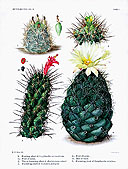 |
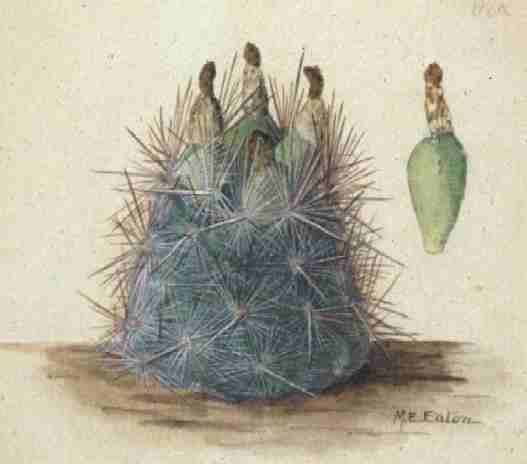 |
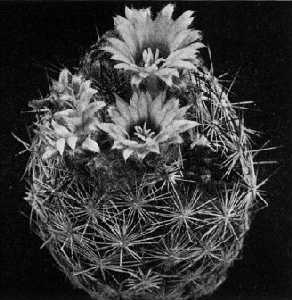 |
| The Cactaceae, 4, pl. 2 | The Cactaceae, 4, pl. 5, f. 1 Eaton, M.E. |
Fig. 43 - Coryphantha neo-mexicana. |
Coryphantha arizonica (Engelmann) Nathaniel Lord Britton et Joseph Nelson Rose comb. nov. , The Cactaceae, 4 : 45, pl. 5, f. 5, 1923
Descriptio:
33. Coryphantha arizonica (Engelmann) N.L.Britton et J.N.Rose comb. nov.
Mammillaria arizonica Engelmann, Bot. Calif. 1: 124. 1876.
Cactus radiosus arizonicus Coulter, Contr. U. S. Nat. Herb. 3: 121. 1894.
Mammillaria radiosa arizonica Schumann, Gesamtb. Kakteen 481. 1898.
Sometimes cespitose, forming large clumps a meter broad; each head globose to ovoid, 7.5
to 10 cm. in diameter; tubercles about 2.5 cm. long, cylindric, ascending, deeply grooved; spines
numerous, straight, rigid; radial spines 55 to 20, 10 to 30 mm. long, whitish; inner spines 3 to 6,
stouter than the radial ones, deep brown above; flowers large, 5 to 7 cm. broad, rose-colored; outer
perianth-segments 30 to 40, linear-subulate, with fimbriate margin; inner perianth-segments 40 to
50, lanceolate-linear, attenuate; stigma-lobes 8 to so, white; fruit oval, green; seeds compressed, light
brown, pitted.
Type locality: Northern Arizona.
Distribution: Northern Arizona, especially along the Upper River of the Grand Canyon,
and perhaps also in southern Utah.*
Mammillaria arizonica Engelmann, when first described, was a complex. Engelmann
states that it was found “on rocky and sandy soil in northern Arizona from the Colorado
eastward (Coues, Palmer, F. Bischoff ) and into southern Utah ( J. E. Johnson); probably
in southeastern California.” Engelmann afterwards described Johnson’s plant from Utah as
M. chlorantha and the California plant is doubtless his M. deserti. We have in the U. S.
National Herbarium Palmer’s specimen from Arizona but we have not seen the plant of
Coues nor of Bischoff.
The northern range of this species is very uncertain. Engelmann extended it into
southern Utah.
Plate v, figure 5, shows a plant sent by M. A. H. Spencer from
the Grand Canyon, Arizona, in May 1907, which afterwards flowered
in Washington.
--------------------------------------------------------------------------------------------------------------
* Our Utah reference is based on some detached flowers collected by M. E. Jones and a barren plant sent by Dr.
C. D. Marsh in 1922. Both collections came from above Salina.
 |
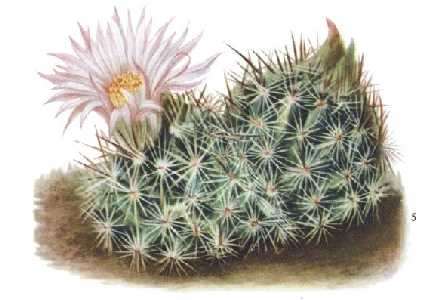 |
| The Cactaceae, 4, pl. 5 | The Cactaceae, 4, pl. 5, f. 5 Eaton, M.E. |
Coryphantha deserti (Engelmann) Nathaniel Lord Britton et Joseph Nelson Rose comb. nov. , The Cactaceae, 4 : 46, 1923
Descriptio:
34. Coryphantha deserti (Engelmann) N.L.Britton et J.N.Rose comb. nov.
Mammillaria deserti Engelmann, Bot. Calif. 2: 449. 1880.
Cactus radiosus deserti Coulter, Contr. U. S. Nat. Herb. 3: 121. 1894.
Cactus radiosus alversonii Coulter, Contr. U. S. Nat. Herb. 3: 522. 1894.
Mammillaria alversonii Zeissold, Monatsschr. Kakteenk. 5: 70. 1895.
Mammillaria radiosa alversonii Schumann, Gesamtb. Kakteen 481. 1898.
Mammillaria radiosa deserti Schumann, Gesamtb. Kakteen 481. 1898.
Solitary or cespitose, usually cylindric, sometimes 2 dm. high, 6 to 9
cm. in diameter, densely covered with spines; radial spines white except
at tip, spreading; central spines several, sometimes as many as 14, much stouter than the radials,
slightly spreading, those toward top of plant connivent, black or bluish black in their upper half,
shading into red, nearly white at base; flowers 3 cm. long and nearly as broad when expanded, light
pink, opening in bright sunlight; scales and outer perianth-segments ciliate; inner perianth-segments
narrow, acute.
Type locality: Ivanpah, California.
Distribution: Deserts of southern California and southern Nevada.
This species is characterized by its stiff spines, with bluish-black tips shading into
red, and is known in southern California as fox-tail cactus. The original description of
Mammillaria deserti states that the flowers are straw-colored, tipped with pink, and this
suggests Coryphantha chlorantha but we believe that it belongs with Mammillaria alversonii,
which certainly has pinkish flowers, and since the name deserti is older than alversonii it
is substituted for it.
Illustrations: Cact. Journ. 1: pl. for February, in part; Alverson’s Cat. pl. facing 8, as
Mammillaria alversonii; Schumann, Gesamtb. Kakteen 480. f. 79, as M. radiosa alversonii.
Figure 44 is from a photograph of a single plant sent by E. C. Rost; figure 45 is from
a photograph of a clump photographed by E. C. Rost in its natural surroundings; figure 46
shows a flower taken from Mr. Rost’s plant.
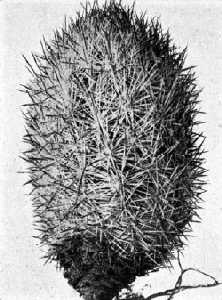 |
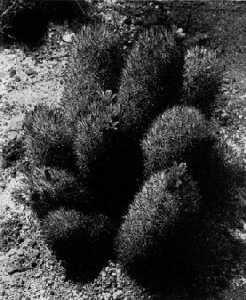 |
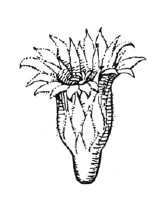 |
| Fig. 44 - Coryphantha deserti. | Fig. 45 - Coryphantha deserti. | Fig. 46 - Flower of C. deserti. |
Coryphantha aggregata (Engelmann) Nathaniel Lord Britton et Joseph Nelson Rose comb. nov. , The Cactaceae, 4 : 47, pl. 4, 1923
Descriptio:
35. Coryphantha aggregata (Engelmann) N.L.Britton et J.N.Rose comb. nov.
Mammilaria aggregata Engelmann in Emory, Mil. Reconn. 157. 1848.
Cereus aggregatus Coulter, Contr. U. S. Nat. Herb. 3: 396. 1896, as to name.
Echinocereus aggregatus Rydberg, Bull. Torr. Club 33: 146. 1906, as to name.
Plants solitary or cespitose, globular to short-oblong, very spiny; radial spines numerous, stouter
than those of Coryphantha vivipara, white, often with brown tips, appressed; central spines several,
stout, all erect and appressed or one often porrect, those towards top of plant connivent; flowers
very large and showy, purplish, 5 to 7 cm. broad; outer perianth-segments ciliate; inner perianthsegments
narrowly oblanceolate, often 6 mm. broad, acute, apiculate; stigma-lobes 8 to so, elongated,
white; fruit green, oblong, 2 to 2.5 cm. long, naked or occasionally bearing a small scale on the
side, juicy; seeds dark brown, 2 mm. long.
Type locality: Head waters of the Gila.
Distribution: Western New Mexico, southeastern Arizona, and northern Sonora.
This species is characterized by its stiff spines, with bluish-black tips shading into
red, and is known in southern California as fox-tail cactus. The original description of
Mammillaria aggregata came from the headwaters of the Gila. The type was not
preserved and is known only from a drawing reproduced in Emory’s report. There has
been much discussion about the identity of the plant; Coulter transferred it to Cereus,
referring to it Cereus coccineus and C. phoeniceus and assigning to it a wide range, Colorado
to San Luis Potosí. Rydberg transferred the name to Echinocereus but applied it
to the same group of plants described by Coulter. A careful restudy of the original illustration
and Engelmann’s description and a restudy of all the cacti of similar habit in
the southwest leads us to a different conclusion from that reached by Dr. Coulter and
Dr. Rydberg. Engelmann, who described it as a Mammillaria, says that it appears to be
allied to M. vivipara, and this we believe is its true relationship. A Mammillaria from
the region about Flagstaff often forms the great clusters mentioned by Engelmann, and
while we believe that it differs from the one found in northern Arizona it is certainly
a near ally, probably representing the closely related species from southeastern Arizona
and southwestern New Mexico which has often passed as M. arizonica.
Engelmann referred a specimen which he had from Sonora to his variety Mammillaria
vivipara neo-mexicana with the remark that it was “a form with more spines than any
other.”
Plate IV shows a clump sent by Mrs. Ruth C. Ross from near Aravaipa, Arizona, in July
1922. Figure 47 is from a photograph of a single plant obtained by Dr. Rose near Benson
May 1, 1908, which afterwards flowered in Washington.
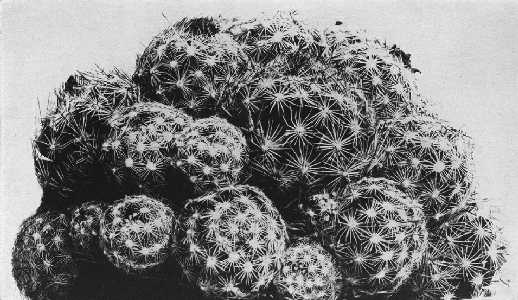 |
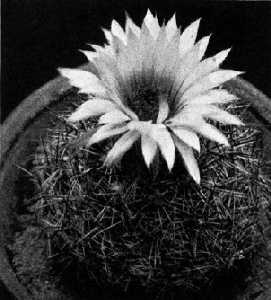 |
| The Cactaceae 4, pl. 4 - Coryphantha aggregata. | Fig. 47 - Coryphantha aggregata. |
Coryphantha cubensis Britton et Rose in Britton et Rose, The Cactaceae, 4 : 48, pl. 5, f. 1, 1923
Descriptio:
36. Coryphantha cubensis N.L.Britton et J.N.Rose, Torreya 12: 15. 1912.
Mammillaria urbaniana Vaupel, Monatsschr. Kakteenk. 22: 65. 1912.
Plants depressed-globose, tufted, 2 to 3 cm. broad, pale green; tubercles numerous, vertically
compressed, 6 to 7 mm. long, 4 to 5 mm. wide, about 3 mm. thick, grooved on upper side from
apex to below middle, the groove very distinct; spines about 10, whitish, radiating, acicular but weak,
3 to 4 mm. long, those of young tubercles subtended by a tuft of silvery white hairs, 1.5 mm. long;
flowers pale yellowish green, 16 mm. high, the segments acute; filaments, style, and stigma-lobes
yellowish; fruit red, less than 1 cm. long, naked; seeds black, somewhat angled.
Type locality: Among stones in barren savanna, southeast of Holguin, Oriente, Cuba.
Distribution: Type locality and vicinity.
This species is very inconspicuous and perhaps for that reason is rare in collections. It
has only twice, to our knowledge, been collected, both times by Dr. J. A. Shafer, once in
1909 (No. 2946) and again in 1912 (No. 12432), who gave a short account of its discovery
in the journal of the New York Botanical Garden (No. 155). He states that it barely
protrudes through the layer of broken stones that filled the interstices between the larger
rocks; that the largest plants were scarcely an inch in diameter, one of them bearing a
small yellowish flower. It lives only a short time in greenhouse cultivation.
On account of the name Mammillaria cubensis Zuccarini (Labouret, Monogr. Cact. 59.
1853) Vaupel gave a new specific name to the plant when he transferred it from
Coryphantha.
Plate V, figure 1, shows the plant collected by Dr. Shafer in 1912 which flowered in the
New York Botanical Garden in July of the same year; figure 1a shows the fruit and figure
1b shows a tubercle from the same plant.
 |
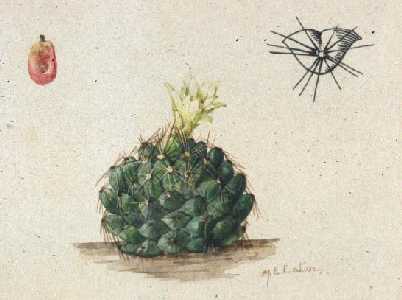 |
| The Cactaceae, 4, pl. 5 | The Cactaceae, 4, pl. 5, f. 1 - Coryphantha cubensis. |
Neobesseya wissmannii (Hildmann) Nathaniel Lord Britton et Joseph Nelson Rose comb. nov. , The Cactaceae, 4 : 52, fig. 50, 1923
Descriptio:
1. Neobesseya wissmannii (Hildmann) N.L.Britton et J.N.Rose comb. nov.
Mammillaria similis robustior Engelmann, Bost. Journ. Nat. Hist. 6: 200. 1850.
Mammillaria nuttallii robustior Engelmann, Proc. Amer. Acad. 3: 265. 1856.
Mammillaria missouriensis robustior S. Watson, Bibl. Index 1: 403. 1878.
Cactus missouriensis robustior Coulter, Contr. U. S. Nat. Herb. 3: 111. 1894.
Mammillaria wissmannii Hildmann in Schumann, Gesamtb. Kakteen 498. 1898.
Cactus robustior Small, Fl. Southeast. U. S. 812. 1903.
Plant solitary, or forming mounds 2 to 3 dm. in diameter and 1 dm. high with 25 heads or more;
areoles elliptic when young, conspicuously whitewoolly, the head usually globose, tubercles rather
large, spreading, somewhat narrowed towards apex; Spines 7 to 14, when young white to brownish, in
age gray with yellow swollen base, acicular, 1.5 to 2 cm. long, sometimes all radial and spreading,
rarely 1 or 2 centrals and these porrect; flowers large, 4 to 5 cm. long, dark yellow; scales
on flower-tube strongly nerved; margin of perianth-segments naked; inner segments abruptly
long-apiculate; fruit globose, 8 mm. in diameter.
Type locality: Not cited, presumably Texas.
Distribution: Central Texas.
Illustration: Blühende Kakteen 1: pl. 5, as Mammillaria wissmannii.
Figure 50 is a reproduction of the illustration cited above.
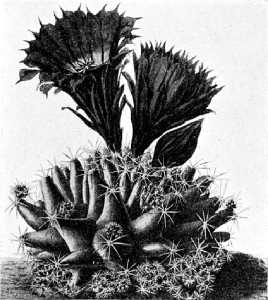 |
| Fig. 50 - Neobesseya wissmannii. |
Neobesseya similis (Engelmann) Nathaniel Lord Britton et Joseph Nelson Rose comb. nov. , The Cactaceae, 4 : 52, fig. 50, 1923
Descriptio:
2. Neobesseya similis (Engelmann) N.L.Britton et J.N.Rose comb. nov.
Mammillaria similis Engelmann, Bost. Journ. Nat. Hist. 5: 246. 1845.
Mammillaria similis caespitosa Engelmann, Bost. Journ. Nat. Hist. 6: 200. 1850.
Echinocactus similis Poselger, Allg. Gartenz. 21: 107. 1853.
Mammillaria nuttallii caespitosa Engelmann, Proc. Amer. Acad. 3: 265. 1856.
Mammillaria missouriensis caespitosa S. Watson, Bibl. Index 1: 403. 1878.
Cactus missouriensis similis Coulter, Contr. U. S. Nat. Herb. 3: 111. 1894.
Mammillaria missouriensis similis Schumann, Gesamtb. Kakteen 498. 1898.
Cactus similis Small, Fl. Southeast. U. S. 812. 1903.
Coryphantha similis Britton and Rose in Britton and Brown, Illustr. Fl. ed. 2. 2: 571. 1913.
Plants sometimes growing in large clumps, to 1.5 dm. high by 2 to 3 dm. in diameter, containing
25 individuals or more; larger plants 6 to 10 cm. in diameter; tubercles deep green, cylindric,
sometimes 2 cm. long, when young the groove filled with white wool; spines all puberulent; radial
spines 12 to , spreading, dirty white with brownish tips; central spine solitary or often wanting,
similar to but stouter and longer than the radials; flowers , to 6 cm. long, light yellow, the outer
lobes tinged with brown and green; inner perianth-segments long, narrow, acuminate; flower-tube
definite, covered nearly to its base with short greenish stamens; style green; stigma-lobes 4 to 6, linear;
fruit globular or short-oblong, 10 to 20 mm. in diameter; seeds large, globose, 2 mm. in diameter.
Type locality: Near Industry, Texas.
Distribution: Eastern Texas.
Engelmann says that the flowers and fruits are larger than in Mammillaria nuttallii.
The inner perianth-segments gradually taper to the apex.
S. Watson and others refer here Mammillaria caespitosa Gray (Struct. Bot. 421. f.
838), but the plant illustrated by Gray is Echinocereus reichenbachii. The Index Kewensis
refers Mammillaria caespitosa Gray, as they also do Mammillaria similis, to Mammillaria
missouriensis. (See Cactaceae 3: 26).
Illustration: Cact. Mex. Bound. pl. 74, f. 7, as Mammillaria nuttallii caespitosa (seed).
Plate in, figure 2, shows a plant collected by F. E. Upham at Fort Worth, Texas, which
flowered in Washington.
Neobesseya missouriensis (Sweet) Nathaniel Lord Britton et Joseph Nelson Rose comb. nov. , The Cactaceae, 4 : 53, pl. 11, f. 4, 1923
Descriptio:
3. Neobesseya missouriensis (Sweet) N.L.Britton et J.N.Rose comb. nov.
Cactus mammillaris Nuttall, Gen. Pl. 1: 295. 1818. Not Linnaeus, 1753.
Mammillaria missouriensis Sweet, Hort. Brit. 171. 1826.
Mammillaria simplex Torrey and Gray, Fl. N. Amer. 1: 553. 1840.
Mammillaria nuttallii Engelmann, Pl. Fendl. 49. 1849.
Mammillaria nuttallii borealis Engelmann, Proc. Amer. Acad. 3: 264. 1856.
Cactus missouriensis Kuntze, Rev. Gen. Pl. 1: 259. 1891.
Mammillaria missouriensis nuttallii Schelle, Handb. Kakteenk. 241. 1907.
Coryphantha missouriensis Britton and Rose in Britton and Brown, Illustr. Fl. ed. 2. 2: 570. 1913.
Plants solitary or cespitose, globose, 2.5 to 5 cm. in diameter; tubercles more or less spiraled,
10 to 15 mm. long; spines 10 to 20, acicular, gray, pubescent, all radial or sometimes 1 central;
flowers greenish yellow; outer perianth-segments narrowly oblong, gradually tapering to an acute
apex, ciliate; inner segments linear-lanceolate, attenuate; fruit globose, scarlet, about 1 cm. in
diameter; seeds mm. in diameter.
Type locality: On the high hills of the Missouri, probably to the mountains.
Distribution: North Dakota to Montana, Colorado to Kansas, Oklahoma, and perhaps northern Texas.
This little cactus has a wide distribution on the Great Plains; both its conspicuous yellow
flowers and its round red fruits are very attractive.
Coryphantha nuttallii, credited to Engelmann, is cited as a synonym of Mammillaria
nuttallii by Rümpler (Förster, Handb. Cact. ed. 2. 407. 1885).
Illustrations: Meehan’s Monthly 10: pl. 3; Gartenwelt 1: 85, as Mammillaria missouriensis;
Gartenwelt 1: 89, as M. missouriensis viridescens; Britton and Brown, Illustr. Fl. 2: f. 2525,
as Cactus missouriensis; Schelle, Handb. Kakteenk. 241. f. 160, as M. missouriensis nuttallii;
Cact. Mex. Bound. pl. 74, f. 6, as M. nuttallii borealis; Blanc, Cacti 72. No. 1426; Blühende
Kakteen 3: pl. 145, as M. nuttallii; Britton and Brown, Illustr. Fl. ed. 2. 2: f. 2984, as Coryphantha
missouriensis.
Plate XI, figure 4, shows a plant from a large clump sent by Professor C. O. Chambers
in 1921 from Stillwater, Oklahoma.
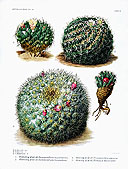 |
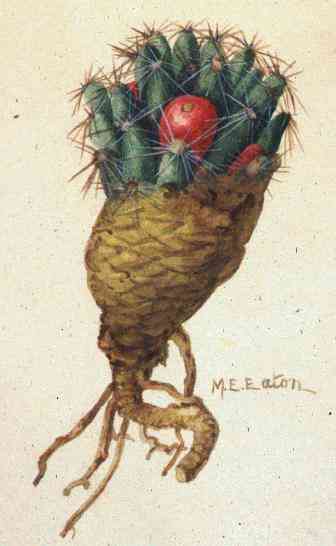 |
| The Cactaceae, 4, pl. 11 | The Cactaceae, 4, pl. 11, f. 4 Eaton, M.E. |
Neobesseya notesteinii (Sweet) Nathaniel Lord Britton et Joseph Nelson Rose comb. nov. , The Cactaceae, 4 : 53, 1923
Descriptio:
4. Neobesseya notesteinii (Britton) N.L.Britton et J.N.Rose comb. nov.
Mammillaria notesteinii Britton, Bull. Torr. Club ,8: 367. 1891.
Cactus notesteinii Rydberg, Mem. N. V. Bot. Gard. 1: 272. 1900.
Oval, solitary or cespitose, about 3 cm. in diameter; tubercles nearly terete, about 6 mm.
high; spines 12 to 18, white, turning gray, weak, slender, 8 to 12 mm. long, pubescent throughout,
a central one usually present and frequently pink-tipped; flowers 15 to 25 mm. broad, ash-gray,
tinged and penciled with pink, the segments broadly linear-oblong, mucronate; fruit obovoid;
seeds black, globose, pitted.
Type locality: Near Deer Lodge, Montana.
Distribution: Known only from the type locality.
Professor F. N. Notestein, who first collected and observed this little cactus, found it in
gravelly soil near a small creek; it differs from the other species of the genus in the color
of the flowers and the more pubescent spines.
Escobaria tuberculosa (Engelmann) Nathaniel Lord Britton et Joseph Nelson Rose comb. nov. , The Cactaceae, 4 : 54, fig. 51, 1923
Descriptio:
1. Escobaria tuberculosa (Engelmann) N.L.Britton et J.N.Rose comb. nov.
Mammillaria strobiliformis Scheer in Salm-Dyck, Cact. Hort. Dyck. 1849. 504. 1850. Not Engelmann,
1848.
Echinocactus strobiliformis Poselger, Allg. Gartenz. 21: 107. 1853.
Mammillaria tuberculosa Engelmann, Proc. Amer. Acad. 3: 268. 1856.
Cactus tuberculosus Kuntze, Rev. Gen. Pl. 1: 261. 1891.
Cactus strobiliformis Kuntze, Rev. Gen. Pl. 1: 261. 1891.
Mammillaria strobiliformis pubescens Quehl, Monatsschr. Kakteenk. 17: 87. 1907.
Mammillaria strobiliformis durispina Quehl, Monatsschr. Kakteenk. 17: 87. 1907.
Mammillaria strobiliformis rufispina Quehl, Monatsschr. Kakteenk. 17: 87. 1907.
Mammillaria strobiliformis caespititia Quehl, Monatsschr. Kakteenk. 19: 173. 1909.
Usually growing in clumps, cylindric or becoming so, 5 to 18 cm. high, 2 to 6 cm. in diameter;
tubercles more or less regularly arranged in spirals, 6 mm. long; radial spines numerous, white, sometimes
as many as 30, acicular, 4 to 15 mm. long; central spines several, stouter than radials, brown
to blackish or colored only at tips, one of them usually porrect; flowers 2.5 cm. in diameter when
fully expanded, light pink; outer perianth-segments acute, ciliate; inner perianth-segments narrowly
pointed; fruit oblong, up to 20 mm. long, red; seeds pitted, with a small ventral hilum.
Type locality: Mountains near El Paso and eastward.
Distribution: Southwestern Texas, southern New Mexico, and adjacent Mexico.
Flowers appear in the afternoon and last for two days at least.
The name Coryphantha tuberculosa occurs in C. R. Orcutt’s Circular to Cactus Fanciers,
1922.
Illustrations: Cact. Mex. Bound. pl. 12, f. 1 to 16, as Mammillaria tuberculosa; Förster,
Handb. Cact. ed. 2. 417. f. 46; Schelle, Handb. Kakteenk. 235. f. 149, as M. strobiliformis.
Figure 51 is from a photograph of the plant sent by Dr. Shreve from near El Paso,
Texas, in 1920.
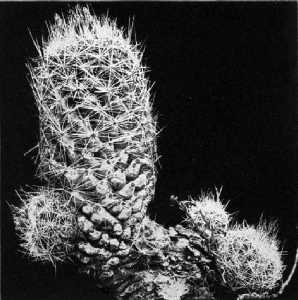 |
| Fig. 51 - Escobaria tuberculosa. |
Escobaria dasyacantha (Engelmann) Nathaniel Lord Britton et Joseph Nelson Rose comb. nov. , The Cactaceae, 4 : 55, pl. 7, f. 1, 1923
Descriptio:
2. Escobaria dasyacantha (Engelmann) N.L.Britton et J.N.Rose comb. nov.
Mammillaria dasyacantha Engelmann, Proc. Amer. Acad. 3: 268. 1856.
Cactus dasyacanthus Kuntze, Rev. Gen. Pl. 1: 259. 1891.
Globose to short-oblong, usually 4 to 7 cm. in diameter but sometimes 20 cm. long; radial
spines 20 or more, white, bristle-like; central spines about 9, stouter and longer than the radials,
upper half usually reddish or brownish, often 2 cm. long; flowers pinkish; perianth-segments
narrowly oblong, ciliate, apiculate; stigma-lobes green; fruit clavate, scarlet, 15 to 20 mm. long;
seeds black, 1 mm. in diameter, slightly flattened, pitted, with a narrow white subbasal hilum.
Type locality: El Paso and eastward.
Distribution: Western Texas, southern New Mexico, and northern Chihuahua.
We have examined the type of this species which was collected by Charles Wright at
El Paso in 1852.
Escobaria dasyacantha is sometimes mistaken for Escobaria tuberculosa, but the stems are
usually globose and the seeds larger and of a different shape. Engelmann speaks of its resemblance
to Echinocactus intertextus dasyacanthus, now Echinomastus dasyacanthus, but this is
only superficial, for the flowers, fruit, and seeds of the two species are very different. The
name Coryphantha dasyacantha occurs in C. R. Orcutt’s Circular to Cactus Fanciers, 1922.
We had never seen this plant in cultivation until it was recently sent by Mrs. S. L. Pattison
from western Texas.
Illustrations: Cact. Mex. Bound. pl. 12, f. 17 to 22, as Mammillaria dasyacantha.
Plate VII, figure 1, shows a plant sent by Mrs. S. L. Pattison from near El Paso, Texas,
in 1921 which flowered in the New York Botanical Garden. Figure 52 is from a photograph
of another plant sent by Mrs. Pattison from the same region.
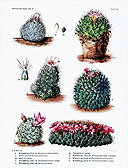 |
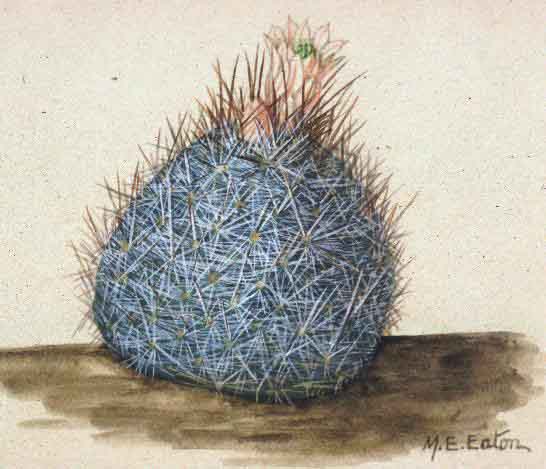 |
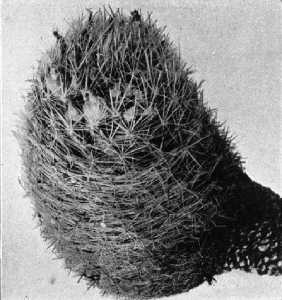 |
| The Cactaceae, 4, pl. 7 | The Cactaceae, 4, pl. 7, f. 1 Eaton, M.E. |
Fig. 52 - Escobaria dasyacantha. |
Escobaria chihuahuensis Nathaniel Lord Britton et Joseph Nelson Rose spec. nov. , The Cactaceae, 4 : 55, 1923
Descriptio:
3. Escobaria chihuahuensis N.L.Britton et J.N.Rose sp. nov.
Plants often solitary, perhaps also cespitose, globose to short-cylindric, very spiny; tubercles
short, usually hidden by the spines; radial spines numerous, spreading; central spines several, longer
than radials, usually brown or black in upper part; flowers small, 1 to 1.5 cm. long, purple;
outer perianth-segments broad, often rounded at apex with ciliate margins; inner perianth-segments
pointed.
Common in the mountains near Chihuahua, where it was collected by Palmer (No. 72,
type) in 1908 and by Pringle (Nos. 250, 251) in 1885.
This plant should be compared with Mammillaria grusonii Runge (Gartenflora 38: 105.
f. 20. 1889). L. Quehl believed that M. grusonii was closely related to M. scheeri, but he
apparently knew it only from the original illustration and description. It does not suggest
any of the species of Coryphantha to us.
Escobaria runyonii Nathaniel Lord Britton et Joseph Nelson Rose spec. nov. , The Cactaceae, 4 : 55, pl. 6, f. 1, 1923
Descriptio:
4. Escobaria runyonii N.L.Britton et J.N.Rose sp. nov.
Caespitose, with numerous (sometimes 100) globose to short-oblong heads, grayish green 3 to 5 cm long with
fibrous roots; tubercules 5 mm long, terete in section with very narrow groove above; groove at first
white-woolly, not glandular; radial spines numerous, acicular, white, 4 to 5 mm long; central spines stouter
than radials, to 7, slightly spreading witj brown or black tips, 6 to 8 mm long; flowers 1,5 cm long, pale
purple; segments with a dark purple stripe down the middle and pale margins; outer perianth-segments narrower
than the outer, with margins entire, acute; filaments purplish; style very pale; stigmalobes 6, green; fruit
scarlet, globose to short-oblong, 6 to 9 mm long, juicy.
Collected by Robert Runyon in July 1921 and again in October of the same year near Reynosa, Mexiko, about
75 miles up the Rio Grande from Brownsville, Texas, and on August 10, 1921, near Rio Grande, Starr County,
Texas. The plant flowered in Washington March 13, 1922.
Plate VI, figure 1, is from a photograph of the type plant taken by Robert Runyon. Figure 53 is from a
photograph taken by Robert Runyon.
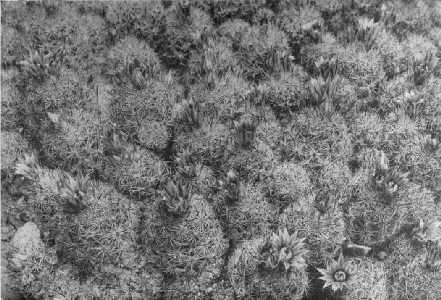 |
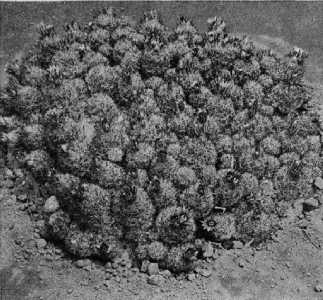 |
| The Cactaceae, 4, pl.6, f. 1 | Fig. 53 - Escobaria runyonii. |
Překlad:
Trsovité, s mnohačetnnými (někdy až 100) kulovitými až krátce válcovitými hlavami, šedozelené 3 ař 5 cm dlouhé s
nitkovými kořeny; bradavky 5 mm dlouhé, v průřezu válcovité s velmi úzkou brázdou na horní straně; brázda zpočátku
s bílou vlnou, bez žláz; okrajové trny, až 7, lehce vzpřímené, s hnědou nebo černou špičkou, 6 až 8 mm dlouhé;
květy 1,5 cm dlouhé, světle purpurové, okvětní lístky s tmavě purpurovým proužkem ve středu a světlými okraji;
vnější okvětní lístky úzce podlouhlé se slabě obrvenými okraji; vnitřní okvětní lístky užší než vnější, celokrajové,
zašpičatělé; nitky trochu purpurové, pestík velmi světlý; 6 zelených bliznových laloků; plod šarlatově červený,
kulovitý až krátce válvovitý, 6-9 mm dlouhý, dužnatý.
Sbíráno Robertem Runyonem v červenci 1921 a opětně v říjnu stejného roku v blízkosti Reynosy, Mexiko, cca 75 mil
(přibližně 120 km) pod Brownsville, Texas, u Rio Grande a 10. srpna 1921 nedaleko od Rio Grande, Starr County,
Texas. Rostliny kvetly ve Washingtonu 13. března 1922.
Část VI, obrázek 1 pochází z fotografie typové rostliny, zachycená Robertem Runyonem. Obrázek 53 je fotografie,
kterou udělal Robert Runyon.
Übersetzung:
Rasenbildend, mit zahlreichen (manchmal 100) kugeligen bis kurz-säuligen Köpfen, graugrün 3 bis 5 cm lang mit
Faserwurzeln; Warzen 5 mm lang, walzenförmig im Profil mit einer sehr schmalen Furche oberseits; Furche zuerst
weiß-wollig, nicht drüsig; Randdornen, bis 7, leicht spreizend, mit braunen oder schwarzen Spitzen, 6 bis 8 mm
lang; Blüten 1,5 cm lang, hell-purpur, Blütenblätter mit einem dunkel-purpur Streifen unterhalb der Mitte und
hellen Rändern; äußere Blütenblätter schmal länglich mit schwach bewimperten Rändern; innere Blütenblätter
schmaler als die äußeren, ganzrandig, spitz; Filamente etwas purpurn; Stempel sehr hell; Narben 6, grün; Frucht
scharlachrot, kugelig bis kurz-säulig, 6-9 mm lang, saftig.
Gesammelt von Robert Runyon im Juli 1921 und erneut im Oktober des gleichen Jahres in der Nähe von Reynosa,
Mexiko, etwa 75 Meilen (etwa 120 km) unterhalb Brownsville, Texas, am Rio Grande und am 10. August 1921 in der
Nähe von Rio Grande, Starr County, Texas. Die Pflanze blühte in Washington am 13. März 1922.
Tafel VI, Bild 1 stammt von einer Photographie der Typ-Pflanze, aufgenommen von Robert Runyon. Bild 53 ist ein
Foto, welches Robert Runyon machte.
Übersetzung: W.Berthold - LBS des AfM, Lieferung 1.7.1986
Escobaria chaffeyi Nathaniel Lord Britton et Joseph Nelson Rose spec. nov. , The Cactaceae, 4 : 56, 1923
Descriptio:
5. Escobaria chaffeyi N.L.Britton et J.N.Rose sp. nov.
Short-cylindric, 6 to 12 cm. long by 5 to 6 cm. in diameter, almost covered by the numerous
white spines; tubercles rather short, light green, with a narrow groove above; radial spines numerous,
spreading, bristly; central spines several, a little shorter than the radials and brown or black-tipped;
flowers 15 mm. long, cream-colored or sometimes purplish; outer perianth-segments ciliate; inner
perianth-segments oblong, obtuse, entire; style white; stigma-lobes very short, yellowish green; fruit
crimson, 2 cm. long.
Collected by Dr. Elswood Chaffey near Cedros, Zacatecas, Mexico, in June 1910 (No.
5, type), and by F. E. Lloyd near the same locality in 1908 (No. 29).
Escobaria sneedii Nathaniel Lord Britton et Joseph Nelson Rose spec. nov. , The Cactaceae, 4 : 56, fig. 54, 1923
Descriptio:
6. Escobaria sneedii N.L.Britton et J.N.Rose sp. nov.
Densely cespitose, sometimes with as many as 50 joints, creeping or spreading; joints cylindric,
up to 6 cm. long, 1 to 2 cm. in diameter; tubercles numerous, hidden under the many spines, terete,
2 to 3 mm. long, in age naked; groove narrow, hairy throughout its length; axils of tubercles not
setose; spines 20 in a cluster or more, nearly white, or the larger ones brown at tip, longest one 6
mm. long, all usually appressed, but the longer ones near top, connivent; flowers small, 10 mm. long
or less when dry, the outer segments long-ciliate; fruit (immature) a little longer than thick, 5 to
7 cm. long, green (?), at first juicy, naked; seeds globose, brown, nearly 1 mm. in diameter, pitted.
This curious little plant was sent us in February 1921 by Mrs. S. L. Pattison from
southwestern Texas; it was collected by J. R. Sneed, who at first found only three clumps,
but afterwards a fourth clump was discovered and again it was found in June 1921 just
after it had flowered. It is known from a single station on the Franklin Mountains, Texas.
According to Mrs. Slater the flowers are pink to saffron.
Figure 54 is from a photograph of a single plant sent by Mrs. Pattison in 1921.
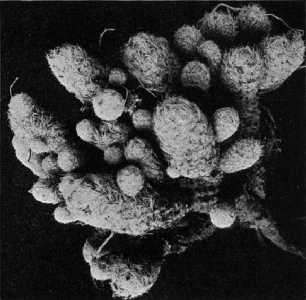 |
| Fig. 54 - Escobaria sneedii. |
Escobaria bella Nathaniel Lord Britton et Joseph Nelson Rose spec. nov. , The Cactaceae, 4 : 56, pl. 7, f. 4, 4a, 1923
Descriptio:
7. Escobaria bella N.L.Britton et J.N.Rose sp. nov.
Cespitose, cylindric, 6 to 8 cm. long; tubercles nearly terete, 1.5 to 2 cm. long, the groove
white-hairy, with a narrow brownish gland near center; radial spines several, whitish, 1 cm. long
or less; central spines 3 to 5, brown, unequal, the largest 2 cm. long or more, ascending; flowers
central, small, rotate, nearly 2 cm. broad; perianth-segments pinkish with pale margins, linear-oblong,
acute, the outer ones ciliate; filaments reddish; upper part of style and stigma-lobes green.
Collected by J. N. Rose and Wm. R. Fitch on hills of Devil’s River, Texas (No. 17991).
Plate VII, figure 4, shows the type, which flowered in the New York Botanical Garden,
March 31, 1914; figure a shows a tubercle with its gland-bearing groove.
 |
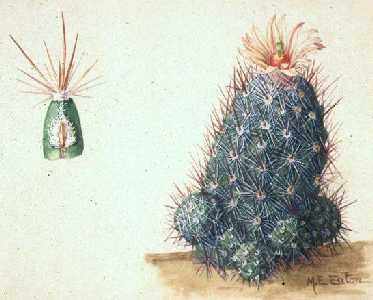 |
| The Cactaceae, 4, pl. 7 | The Cactaceae, 4, pl. 7, f. 4, 4a Eaton, M.E. |
Escobaria lloydii Nathaniel Lord Britton et Joseph Nelson Rose spec. nov. , The Cactaceae, 4 : 57, 1923
Descriptio:
8. Escobaria lloydii N.L.Britton et J.N.Rose sp. nov.
Plant growing in clumps and resembling a small species of Echinocereus; old plants bearing
naked corky tubercles; radial spines about 20, spreading, slender, white; central spines several, stout,
with black or with brownish tips, 2 cm. long; flowers greenish with a central stripe on outside,
2.5 cm. long; filaments, style, and stigma-lobes green; fruit red, globose to short-oblong, 6 to 12
mm. long; seeds black, pitted, globose, 1 mm. in diameter.
Collected by F. E. Lloyd in foothills of Sierra Zuluaga, Zacatecas, Mexico, March 29,
1908 (No. 5).
This species is near Escobaria tuberculosa, but it has much stouter central spines and
greenish white, eciliate inner perianth-segments.
SPECIES PERHAPS OF THIS RELATIONSHIP.
The Cactaceae, 4 : 57, 1923
Mammillaria emskoetteriana Quehl, Monatsschr. Kakteenk. 20: 139. 1910.
Cespitose, globose to short-cylindric, 5 cm. high; tubercles conic, their axils naked; radial spines
20 to 25; central spines 6 to 8, setaceous, white with black tips; flowers brownish yellow, 3 cm. long.
Type locality: Not cited.
We obtained a specimen of this plant from Quehl in 1913, but it has not done well nor
has it flowered and we have not been able to refer it to any described species, but believe
that it may be near Escobaria tuberculosa. Mr. Quehl believed that it was near Mammillaria
dasyacantha, but if it came from San Luis Potosí, as Mr. Quehl supposed, it is doubtless
specifically distinct from both. The following note is a translation of some remarks by Mr.
Quehl:
“Our illustration shows a grafted specimen which has naturally grown more corpulent and
consequently permits one to see better its general structure and the arrangement of the spines.
Ungrafted specimens are thicker, lower, and, without other characteristics, can not be distinguished
from a red-spined Mammillaria pusilla var. multiceps. Only a closer inspection reveals the wartfurrows
and consequently the Coryphantha. The similarity is so great that I suspect that the new species
is already more disseminated though not correctly recognized and the plants are either set aside
or ignored as a form of Mammillaria pusilla. The plants before me were raised by Mr. Robert
Emskötter, fancy and commercial gardener, of Magdeburg, after whom I have named the species,
from mixed seed which he received from San Luis Potosí, so that Mexico may be regarded as
its home.”
Illustration: Monatsschr. Kakteenk. 20: 139.

© 2002-2007 Jan Mynar
Last modified August 29, 2007